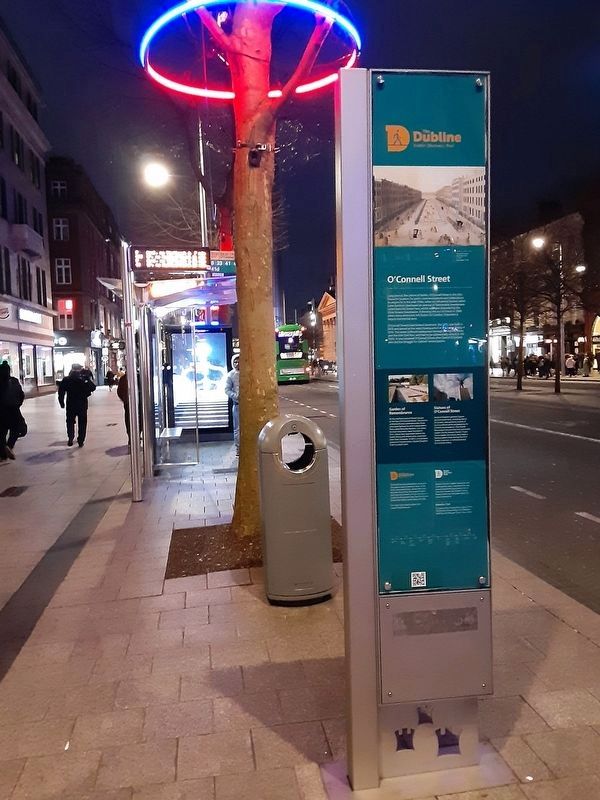North City in Dublin in County Dublin, Leinster, Ireland — Mid-East (and Dublin)
O'Connell Street
[Top photo caption reads]
Sackville Street, looking north, c.1750,
by Joseph Tudor
O'Connell Street
Long seen as the centre of Dublin, O'Connell Street is the city's favourite location for public commemorations and celebrations. Its origins lie in the mid-1700s, when an influential banker called Luke Gardiner developed an avenue of fashionable townhouses called Sackville Street here, which was later extended by the Wide Streets Commission. Following the Act of Union in 1800, when many aristocrats left Dublin for London, it became a largely commercial area.
O'Connell Street's best-known landmark, the GPO, was built in 1818 and served as the rebel headquarters in the Easter Rising of 1916. The street suffered widespread damage during the Rising and the Irish Civil War, and had to be substantially rebuilt in the 1920s. It was renamed O'Connell Street after Daniel O'Connell, who led the struggle for Catholic emancipation.
Garden of Remembrance
At the northern end of Parnell Square, at the top of O'Connell Street, the Garden of Remembrance commemorates those who died fighting for Irish independence. Then called Rotunda Gardens, it is where the Irish Volunteers were founded in 1912, where they assembled before the Easter Rising and where some were held after their surrender. In 2011, in a symbolic gesture of reconciliation, Queen Elizabeth II laid a wreath here.
Statues of O'Connell Street
Some of Ireland's greatest figures are honoured here, including Daniel O'Connell, who spoke to crowds of up to a million while campaigning for Catholic emancipation. The Parnell Monument honours the Irish nationalist leader Charles Stewart Parnell. Trade Union leader Jim Larkin, who made a famous speech here during the 1913 Dublin Lock-out, is commemorated by a bronze statue.
The Dubline Dublin Discovery Trail
The Dubline is an orientation route and the easiest way to explore many of the city's most visited sites. Along the route, discover the stories that shaped Dublin and trace the timeline of our city from its origins to the present day. Explore at your leisure the hidden gems along the way.
For more information please visit:
www.VisitDublin.com
Dublin Discovery Trails
Explore Dublin's hidden treasures with a self-guided walk. Download the app at www.dublindiscoverytrails.com or from the nearby Visit Dublin Centre. Please follow the QR codes below for more information.
Rebellion Trail
To explore the extraordinary story of the 1916 Easter Rising follow the Rebellion walking trail through Dublin city centre.
[Timeline not transcribed]
[Opposite side of marker, in Gaelic, needs photographed and transcribed]
Erected by The Dubline Dublin Discovery Trail.
Topics. This historical marker is listed in this topic list: Notable Places. A significant historical year for this entry is 1800.
Location. 53° 21.051′ N, 6° 15.63′ W. Marker is in Dublin, Leinster, in County Dublin. It is in North City. Marker is on O'Connell Street Upper, 0.1 kilometers south of Parnell Street, on the left when traveling south. Touch for map. Marker is at or near this postal address: 14 O'Connell Street Upper, Dublin, Leinster D01 WP59, Ireland. Touch for directions.
Other nearby markers. At least 8 other markers are within walking distance of this marker. Jim Larkin (about 180 meters away, measured in a direct line); Nelson and the Spire / Nelson agus an Tϊr Solais (about 210 meters away); Sir John Gray, Kn[igh]t. MD. JP. (approx. 0.3 kilometers away); Captain Thomas Joseph Wafer (approx. 0.3 kilometers away); The Oval Bar (approx. 0.3 kilometers away); Independent House (approx. 0.3 kilometers away); Ireland's First Radio Broadcast (approx. 0.3 kilometers away); Wynn's Hotel Dublin (approx. 0.3 kilometers away). Touch for a list and map of all markers in Dublin.
Also see . . . The Dubline Trail. (Submitted on February 15, 2024, by William Fischer, Jr. of Scranton, Pennsylvania.)
Credits. This page was last revised on February 15, 2024. It was originally submitted on February 15, 2024, by William Fischer, Jr. of Scranton, Pennsylvania. This page has been viewed 41 times since then. Photo 1. submitted on February 15, 2024, by William Fischer, Jr. of Scranton, Pennsylvania.
Editor’s want-list for this marker. Photo of opposite side of marker, and Gaelic text transcription added • Can you help?
